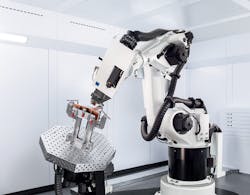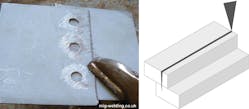Laser process yields fewer defects, does not require part preparation AND POST-PROCESSING
MASOUD HAROONI
There have been discussions about the use of laser welding in production and the advantages that can be achieved. It is typically a commitment, and risk, for industries to implement new technologies, but users can benefit from the advantages that new technologies bring to the table (FIGURE 1). This also helps the customer stay ahead of the competition with better quality and less cost per part due to faster cycle times and no consumable costs.
But, why laser welding? The laser welding process has advantages that can help produce parts faster, as well as eliminate the pre- and post-process efforts to manufacture a quality part. Before elaborating on these efforts, we should first consider one of the main advantages of the laser welding process compared to other conventional fusion welding methods.
Heat matters
Heat is the most important aspect of any fusion weld. However, extra heat input is also the source of metallurgical and mechanical issues such as cracking and distortion. One of the most important advantages of laser welding is the heat input to the part is much less (low total heat input) compared to other conventional welding methods such as metal inert gas (MIG) or tungsten inert gas (TIG).
The key in the laser welding process is that the energy (heat) is transferred through a very small focused beam area to the part, which results in a high energy density. Therefore, not much heat is required to penetrate and weld two pieces of metal together. When using a conventional arc welding method, the heat is transferred through arc, which has a much larger area compared to a laser beam. This results in less heat density while still having enough energy input to create the molten pool on the part. An increase in residual heat can lead to distortion and cracking.
Here is a brief example to make the heat input comparison between laser welding and traditional arc welding more transparent. Imagine you are on a sandy beach with a small box that weighs around 5 lbs, a glass bottle, and a sharp needle. Consider the weight of the box as heat, the bottle as the traditional arc welding method, and the needle as the laser welding process. If you put the bottle on the sand with the box on top of it, is it going to penetrate to the sand? The answer is no, so you would probably need more weight to penetrate. Now, when 5 lbs of weight is put on a needle, it fully penetrates the sand and the excess weight needs to be decreased. This is the difference between laser welding and conventional arc welding—furthermore, the extra heat input required in conventional arc welding processes causes the post-welding issues mentioned earlier.
Now the question is, how will this reduced total heat input effect help you to eliminate extra processes prior to and after laser welding? Let’s start with pre-processes, widely known as weld preparation, for the parts and joints that use beveling or machining of slots for the joining of thicker parts. In laser welding, most of these preparations are not required—this is mainly for thick, heavy industry plates. As discussed earlier, due to the high energy density of the laser penetrating into the part, no slot is required to be machined, especially in thicker parts.
No part preparation needed
To weld thicker parts with conventional arc welding, certain preparations should be done on the part to weld them together in an overlap configuration (FIGURE 2). However, in laser welding, no preparation is required. As can be seen, after welding the parts in this configuration with MIG welding, a post-process effort is required to grind the weld crown to smoothness. Beveling is another pre-process operation that is required for MIG welding of thicker plates. This process requires the machining of parts before moving to the welding process. Using the laser welding process, there is no need to bevel the part prior to laser welding, which helps to save on machining time and on final cost per part. This again helps to adjust the price of the part due to lower cycle time to produce a part.No post-processing required
On aesthetic welds that require good visual quality (for industries such as appliances), laser welding helps to eliminate the post-process requirements. As discussed earlier, controlled heat input, by changing the focus size of the beam, helps to melt the two metals in a joint that does not need any post-processing such as grinding. FIGURE 3 shows the quality that can be expected in laser-welded parts for an aesthetic look. This will save production time and cost on consumables and headcounts, which again results in lower-cost finished parts in production.Cost savings on design adjustments
It is important to mention that not only will there be time/cost savings on laser welding itself, but this process will help save production costs on upstream manufacturing processes such as laser cutting and bending. Traditionally, it is more suitable to have less overall weld seams in the part. However, with the quality and speed that laser welding brings to the game, having more weld seams may be desired in many cases.
FIGURE 4 shows a water tank that is laser-welded—this part has six pieces that assemble using tabs and slots. Instead of having four bends, all bends are eliminated. This helps increase sheet utilization in the laser cutting process since all the parts are almost square. This will also help to eliminate scrap material, resulting in less cost per part. With laser welding, there is a great flexibility in design adjustments on parts that can benefit users. There are different design concepts that would not only affect the final shape or geometry of the part, but also reduce production costs significantly.The examples shown in this article only part of the benefits that this new technology can bring to manufacturers.
REFERENCE
1. See http://bit.ly/ILSMayJunRef.
Dr. MASOUD HAROONI ([email protected]) is Product Manager – Laser Welding at the TRUMPF Smart Factory, Hoffman Estates, IL; www.trumpf.com.



